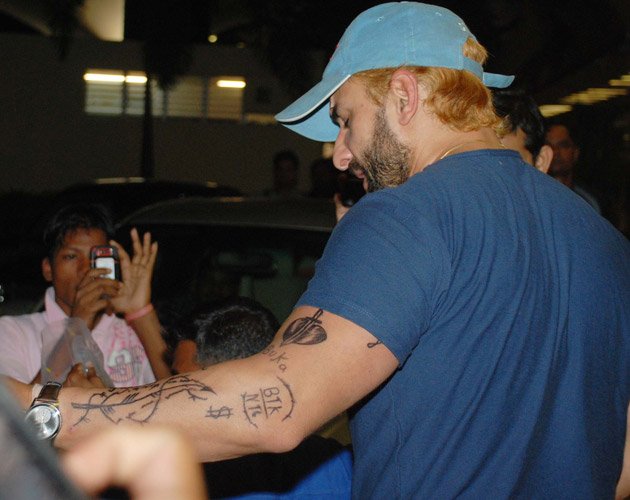
Decoding Saif Ali Khan’s Hand Tattoo: Meaning, Significance, and Evolution
Saif Ali Khan, the Bollywood icon known for his versatile acting and royal lineage, has always been a subject of public fascination. Among the many aspects of his persona that intrigue fans, his hand tattoo stands out prominently. The Saif Ali Khan hand tattoo, a simple yet profound inscription of his wife Kareena Kapoor’s name in Devanagari script, has become a symbol of love and commitment, sparking curiosity and admiration alike. This article delves into the meaning, significance, and evolution of this iconic tattoo, exploring its impact on popular culture and the broader context of celebrity tattoos.
The Origin and Meaning of the Tattoo
The Saif Ali Khan hand tattoo first caught public attention in the late 2000s, shortly after Saif and Kareena began dating. The tattoo, inked on his forearm, reads ‘Kareena’ in Devanagari, an ancient Indian script. The choice of script adds a layer of cultural significance, reflecting Saif’s connection to his Indian heritage. The tattoo is not just a declaration of love but also a testament to the couple’s commitment to each other.
At the time, celebrity tattoos were gaining popularity, but few were as personal and meaningful as Saif’s. Unlike fleeting trends or generic designs, the Saif Ali Khan hand tattoo was a permanent expression of his feelings, a bold statement in an industry often characterized by transient relationships. It quickly became a symbol of modern romance, admired for its simplicity and sincerity.
The Significance of the Devanagari Script
The decision to use Devanagari script for the Saif Ali Khan hand tattoo holds considerable cultural weight. Devanagari is the script used for Hindi, Sanskrit, and several other Indian languages. It is considered a sacred script in Hinduism and is often associated with spirituality and tradition. By choosing Devanagari, Saif subtly acknowledged his cultural roots and infused his declaration of love with a sense of timelessness.
Furthermore, the use of Devanagari adds an element of mystique for those unfamiliar with the script. It transforms a simple name into an intriguing symbol, inviting curiosity and sparking conversations. The Saif Ali Khan hand tattoo, therefore, transcends its literal meaning and becomes a cultural artifact, representing the intersection of love, tradition, and celebrity.
The Impact on Popular Culture
The Saif Ali Khan hand tattoo had a significant impact on popular culture, influencing trends and inspiring fans. Following its debut, many individuals, both in India and abroad, began to emulate the idea of tattooing their loved ones’ names in various scripts. Tattoo parlors reported a surge in requests for Devanagari tattoos, demonstrating the widespread appeal of Saif’s gesture.
Moreover, the tattoo contributed to the normalization of public displays of affection among celebrities. In an industry where personal lives are often scrutinized, Saif’s bold declaration of love set a new precedent, encouraging others to express their feelings openly and honestly. The Saif Ali Khan hand tattoo became a symbol of genuine connection, resonating with audiences seeking authenticity in celebrity relationships.
The Evolution of the Tattoo Over Time
Over the years, the Saif Ali Khan hand tattoo has remained a constant presence in his public image. Despite the passage of time and the inevitable changes in life, the tattoo has served as a reminder of his enduring love for Kareena. It has been photographed countless times, appearing in magazine covers, paparazzi shots, and film stills, solidifying its status as an iconic symbol.
While some celebrity tattoos are later regretted or removed, the Saif Ali Khan hand tattoo has stood the test of time. It has become an integral part of Saif’s identity, a visual representation of his personal history and unwavering commitment. The tattoo’s permanence reflects the enduring nature of his relationship with Kareena, further enhancing its significance.
Expert Opinions and Tattoo Trends
Tattoo artists and cultural commentators have offered various perspectives on the Saif Ali Khan hand tattoo. Many admire its simplicity and elegance, praising Saif’s choice of script and placement. Some have noted its influence on tattoo trends, highlighting the increasing popularity of personalized and meaningful designs.
Experts also point out the importance of considering the long-term implications of getting a tattoo. Unlike fleeting fashion trends, tattoos are permanent and should reflect enduring values and beliefs. The Saif Ali Khan hand tattoo exemplifies this principle, representing a love that has stood the test of time.
The Enduring Legacy of the Saif Ali Khan Hand Tattoo
In conclusion, the Saif Ali Khan hand tattoo is more than just ink on skin; it is a symbol of love, commitment, and cultural connection. Its impact on popular culture is undeniable, inspiring trends and normalizing public displays of affection. The tattoo’s enduring presence in Saif’s public image reflects the lasting nature of his relationship with Kareena and its influence will continue to be felt for years to come.
From its humble beginnings as a personal declaration of love to its current status as an iconic symbol, the Saif Ali Khan hand tattoo has evolved into a cultural phenomenon. It serves as a reminder that even in the fast-paced world of celebrity, genuine connections and meaningful gestures can leave a lasting impact. The Saif Ali Khan hand tattoo remains a powerful symbol of love, culture, and personal expression.
Ultimately, the story of the Saif Ali Khan hand tattoo is a testament to the power of personal expression and the enduring appeal of genuine emotion. It reminds us that even in the age of fleeting trends and superficial connections, true love and meaningful gestures can leave a lasting mark on the world. The Saif Ali Khan hand tattoo continues to inspire and captivate, solidifying its place in popular culture and celebrity history.
[See also: Celebrity Tattoos and Their Meanings]
[See also: Bollywood Couples and Their Love Stories]
[See also: Devanagari Script in Modern Culture]
